Infrastructure investment: evidence summary
This paper summarises evidence on the link between infrastructure investment and economic growth.
Summary
Background
1. Scotland’s Economic Strategy has the twin pillars of increasing competitiveness and reducing inequality at its core. Infrastructure has an important role to play in delivering these objectives.
2. The Scottish Government has recently announced a new National Infrastructure Mission that will lead to a step change in the level of Scotland’s annual infrastructure investment – the Mission is to increase annual investment in infrastructure by 1% of current GDP, or £1.56 billion, by the end of the next Parliament in 2025-26.
3. This paper explores the economic rationale for infrastructure investment and illustrates the potential economic benefit from the Scottish Government’s National Infrastructure Mission.
Key points
4. The Scottish Government headline definition of infrastructure is:
“The physical and technical facilities, and fundamental systems necessary for the economy to function and to enable, sustain or enhance societal living conditions.”
5. Typically infrastructure refers to economic infrastructure, such as utility networks, transport and digital communications, but the Scottish Government also includes social infrastructure such as schools, universities, hospitals, prisons, community housing and parks, in line with the strategy to boost inclusive economic growth.
6. The main channels through which infrastructure enables inclusive and sustainable growth are through its role in:
- Supporting the foundations of economic activity
- Stimulating demand in the economy in the short to medium term
- Improving the supply side of the economy in the longer term (through enhancing productivity and productive capacity)
- Improving the efficiency of markets (through facilitating the development of key sectors and technologies, unlocking private sector capital, improving private sector competitiveness)
- Improving social and environmental outcomes (through reducing regional disparities, reducing emissions, improving environmental quality and health and wellbeing)
7. Empirical analysis of the benefits from infrastructure has tended to focus on exploring the impact on the economy, particuarly the impact on economic output. These studies point to a positive impact of infrastructure investment on economic utput.
8. The question then is whether evidence suggests that there is a need for further investment in infrastructure. Studies by the OECD have shown that infrastructure investment in the UK, which has traditionally been broadly in line with investment levels in Scotland, has historically been lower than other comparable countries. Compared to other OECD members, the UK has lower levels of both government and business investment. Annual UK government investment is around 2.6% of UK GDP: a full one percentage point lower than the OECD average. The UK, and Scotland, therefore have the potential to benefit from increasing the level of infrastructure investment.
9. OECD analysis also shows that the infrastructure stock in all countries (bar Japan) would see positive returns from increasing annual investment in terms of long-term growth and labour productivity. This implies that most countries would see an economic boost from increasing levels of infrastructure invesment.
10. This paper presents new economic analysis by the Scottish Government showing that the National Infrastructure Mission could lead to a sustained boost in Scottish GDP by between 0.5% to 1% by 2025-26, depending on the measure of the economy used.
11. Over 15 years, this is equivalent to increasing the economy by between £10 billion and £25 billion (2017 prices), depending on the measure of the economy used. This confirms the role of infrastructure investment in improving the productive capacity of the economy and delivering long run economic benefits.
Conclusions
12. There is a strong body of evidence which supports the link between infrastructure spending and improved economic growth.
13. An increase in annual infrastructure investment of the scale envisaged in the National Infrastructure Mission could provide a permanent boost to Scotland’s economic growth.
14. Overall, and in common with the OECD results, the economic modelling finds that an investment led stimulus has both a short term demand effect but also a longer term supply effect by increasing the long term productive capacity of the economy.
15. The extent of economic benefits will be shaped by the efficiency of the individual public investment projects. Ultimately, the balance of investment between different types of activity, sectors and markets will determine the precise level of economic benefits realised from the infrastructure investment package.
I. How Does Infrastructure Enable Sustainable and Inclusive Growth?
1. The Scottish Government defines infrastructure as:
“The physical and technical facilities, and fundamental systems necessary for the economy to function and to enable, sustain or enhance societal living conditions.
These include the networks, connections and storage relating to enabling infrastructure of transport, energy, water, telecoms, digital and internet, to permit the ready movement of people, goods and services. They include the built environment of housing; public infrastructure such as education, health, justice and cultural facilities; safety enhancement such as waste management or flood prevention; and public services such as emergency services and resilience.”
2. Infrastructure investment can boost the economy in two main ways:
- Directly in the short term through employment and purchasing inputs from other sectors and related multipliers; and
- Indirectly in the long term, through raising the productive capacity of the economy by reducing transaction and other costs allowing a more efficient use of inputs.
3. Infrastructure is an enabler of sustainable and inclusive growth and the main channels are summarised in Figure 1.
Figure 1: How Infrastructure Investment Enables Inclusive and Sustainable Growth
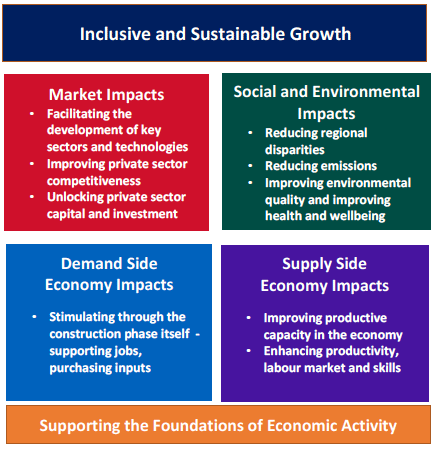
4. The main channels through which infrastructure enables inclusive and sustainable growth are through its role in:
Supporting the Foundations of Economic Activity
- Infrastructure underpins economic resilience (e.g. flood defences, energy security), provision of lifeline services (e.g. island ferries) and the effective operation of the economy (e.g. through a safe road network).
Demand Side Economy Impacts
- The construction phase of infrastructure projects is an important source of employment and can provide wider supply chain benefits that support economic activity across the country in the short to medium term. This is particularly through the purchase of inputs from sectors.
- The pipeline of infrastructure projects needs to be carefully managed to avoid creating capacity constraints in the construction sector which could lead to cost inflation and could displace activity elsewhere in the economy.
Supply Side Economy Impacts
- Infrastructure spending can enhance the productive potential of the economy, if investment is effective, through improving its supply side. For example, improved connectivity such as through better public transport connects firms to larger pools of skilled labour, allowing them to recruit staff with the best skill set and improve labour productivity.
- Investment in social infrastructure, such as schools, can support long term economic growth if the investment leads to improved outcomes. For example, if an improved school estate ultimately leads to improved skills among school leavers it can feed through to higher productivity.
Market Impacts
- Facilitating the development of key sectors and technologies: Investment in infrastructure which is underpinned by new technologies (e.g. satellite launch facilities, renewable energy technology) can facilitate the development of new industries and supply chains. Likewise, investment which supports the early adoption of new technologies, such as the Scottish Government’s investment in the electric vehicle charging network and marine energy, can give a country an early foothold in new emerging industries.
- Improving private sector competitiveness: Competition helps drive down prices and increase quality and variety of services. For example, access to reliable and cost effective energy reduces companies’ operating costs, transport hubs open up new markets, and improved digital connectivity can provide the basis for new operating techniques.
- Unlocking private sector capital: Infrastructure is a catalyst for private sector investment including Foreign Direct Investment. For example transport infrastructure in an important criterion for multinational firms when choosing to invest. New transport hubs (e.g. harbour, public transport interchange) can provide the facilities required for new businesses to operate, or new housing developments. Infrastructure projects are in principle also attractive assets for private sector investors, such as pension funds.
Social and Environmental Impacts
- Reducing regional disparities. Infrastructure has a geographic dimension through agglomeration, improving regional connectivity and improving accessibility (for example through providing new economic opportunities to remote and deprived communities). For example, expanding rural broadband offers new opportunities for remote businesses. Likewise, improvements to the public transport network (e.g. Borders Railway) allow residents in more remote locations to commute to economic hubs such as Edinburgh or Glasgow. These links also make rural communities more attractive places for skilled workers to live, who in turn can support the local economies.
- Reducing emissions and improving environmental quality and improving health and wellbeing. Infrastructure can reduce greenhouse emissions through the development and use of lower carbon technologies. Some forms of infrastructure investment, such as clean water, directly lead to improvements in environmental quality and clean water is essential for health and wellbeing.
II. To What Extent Does Infrastructure Investment Impact on Growth?
5. Although infrastructure can lead to wide range of economic and social outcomes, the area that has received the closest attention in terms of empirical analysis is the impact of infrastructure spending on economic output, and the size of the growth effects has been the subject of extensive debate.[1] There is evidence from literature reviews (using meta-analysis) that finds that the average elasticity of GDP with regards to public capital stock is around 0.1[2] which points to an overall positive impact of infrastructure investment on GDP. The quantitative evidence on the extent to which infrastructure spending reduces inequality across regions and people groups is more tentative, in part, owing to data limitations.[3]
6. Table 1 summarises the estimates of the impact of infrastructure on economic output that are available from cross-country studies that have used econometric techniques to establish the relationship between public investment and economic output. Table 1 notes the methodological approach used along with key findings.
7. Each study has explored slightly different questions on the links between infrastructure and economic growth. The studies have used different modelling methodologies to explore the impact on economic outputs. Nevertheless, the studies in Table 1 show a positive effect of infrastructure on economic growth.
Table 1: Studies Modelling the Relationship Between Infrastructure Spending on Economic Output
Study |
Modelling Approach |
Findings |
|---|---|---|
OECD (2016a) [4] |
An econometric model is specified where growth is a function of production, public spending and other variables. |
Increasing the share of public investment in primary spending by 1 percentage point (offset by a reduction in other spending) would increase the long term GDP level by about 5%. Also finds that the marginal returns to public investment decrease when the public capital increases. |
OECD (2016b)[5] |
Three different macro-econometric models are used. The models differ particularly around the number of advanced economies included and therefore the extent to which they capture international trade effects. |
A sustained investment stimulus of half percentage point of GDP is estimated to lead to average long term output gains between 0.5% to 2% in the large advanced economies. |
IMF (2014)[6] |
An econometric model is specified where public investment shocks are identified as the forecast error of public investment spending relative to GDP. |
1 percentage point of GDP increase in investment spending increases the level of output by 0.4% in the same year and by 1.5% four years after the public spending shock. |
European Commission (2014)[7] |
An econometric model is specified where GDP per capita is a function of infrastructure provision per capita (focusing on transport and electricity infrastructures). |
Finds a positive relationship between transport and electricity infrastructure and economic growth in the long term. Policies promoting spending in transport and electricity infrastructures can lead to positive impacts on growth provided there is no overprovision of infrastructure. |
8. Although the studies show a positive effect of infrastructure on economic growth at an aggregate level, the extent to which such effects are realised clearly depend on country specific factors, such as the level of existing provision. OECD (2016b) finds that countries where the initial level of public capital is low are likely to benefit the most from the investment on the assumption that additional investment has a high risk adjusted rate of rate of return in these countries.
9. Another determinant of the magnitude of effect is the type of investment: the OECD (2016a) note that that some forms of public investment can be more beneficial than others with the EC (2014) study demonstrating economic benefits in transport and electricity. Related to this is that the fact that the impact of new investments on growth will depend on the overall state and extent of the network – since many infrastructure services are often provided through networks, and so returns to users increase with the number of users.
10. Overall, the IMF (2014) note that the gains from infrastructure investment are also shaped by the degree of economic slack, the efficiency of public investment and the method of financing.
III. How do the Levels of Infrastructure Investment in Scotland and the UK Compare to Other Countries?
11. Having set out the economic benefits that infrastructure investment can bring, this section explores current levels of investment relative to other countries before considering in more detail what the ‘optimal’ level of investment might be in the following section.
12. The level of infrastructure investment, and capital spending more broadly, can be measured using a variety of indicators. A common measure of capital investment is gross fixed capital formation (GFCF) which measures expenditure on non-financial assets by both the public and private sectors. More specifically it measures the net acquisitions of assets such as land, buildings, software, transport equipment and machinery used in the production process for more than one year.[8]
13. Figure 2 shows an international comparison of infrastructure spending in OECD countries. Scotland and the UK have historically had comparatively low levels of investment. Indeed, prior to 2008 Scotland and the UK had the lowest levels of GFCF in the OECD. Due to falls in investment in other countries (such as Greece and Portugal) this is no longer the case, but investment remains among the lowest in the OECD.
Figure 2: Expenditure on Gross Fixed Capital Formation as a percentage of Gross Domestic Product, OECD nations, UK, Scotland, 1998 to 2017
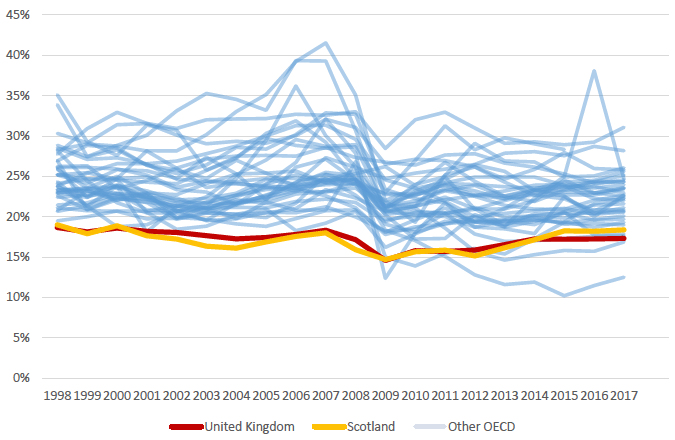
Source: Organisation for Economic Co-operation and Development (OECD) and Scottish Government calculations
14. Figure 2 shows both public and private GFCF. Scotland is currently developing internationally comparable measures of government GFCF as part of the development of its National Accounts. It is likely that these will show that, as for overall investment, and similar to the UK, government investment in Scotland is low compared to other OECD countries.
15. Figure 3 below shows that between 1995 and 2003, the UK was in the bottom 10th percentile of government investment in non-financial assets of all OECD nations.[9] In this period, government expenditure on GFCF made up just 1.8% of total GDP. In the years since 2003, this average has increased to 2.7% of GDP (average 2003 to 2015) and the UK has climbed out of the bottom 10th percentile of OECD countries, but still remains well below the OECD average.
16. Annual UK government investment is around 2.6% of UK GDP in 2015: a full one percentage point lower than the average OECD figure.
Figure 3: Government expenditure on Gross Fixed Capital Formation as a percentage of Gross Domestic Product, UK and OECD nations, 1995 to 2015
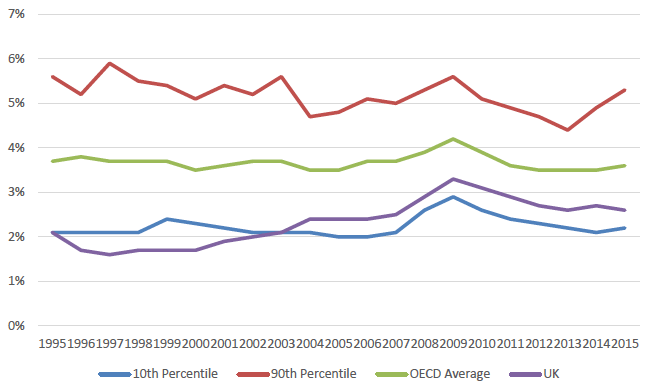
Source: Organisation for Economic Co-operation and Development (OECD)
17. Looking at individual countries in the G7, Figure 4 shows that Germany has the lowest average government expenditure on GFCF as a percentage of GDP in the latest year shown, followed by Italy and then the UK.
Figure 4: Government expenditure on Gross Fixed Capital Formation as a percentage of Gross Domestic Product, G7 nations, 1995 to 2015
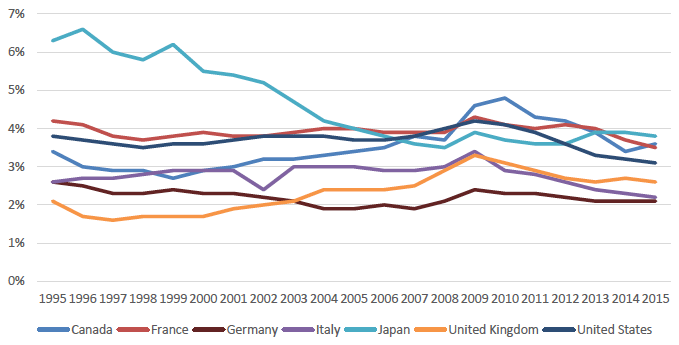
Source: Organisation for Economic Co-operation and Development (OECD)
18. Overall, this analysis suggests that government infrastructure investment in the UK has been consistently lower than the OECD average, despite increases since the financial crisis. Annual UK government investment is around 2.6% of UK GDP: a full one percentage point lower than the OECD average.
19. The approach to using indicators of GFCF is only one way to identify the rationale for further infrastructure investment. There are further indicators which are drawn largely from the OECDs comprehensive report on improving the UKs infrastructure.[10] These can be summarised as:
- The degree of regional disparity in investment. The OECD (2015) found regional disparity in the quality of infrastructure between the South East (including London) and the rest of the country and argued that was partly attributable to insufficient long-term planning by successive governments.
- The level of investment in specific types of infrastructure compared to other countries. For example, the OECD report found that the UK’s digital economy is well developed and has made progress but it lags behind the best performing countries in the EU.
- Signs of capacity constraints, that is, where demand exceeds supply and where inadequate infrastructure is imposing congestion costs. For example, in transport, the OECD study found that there are indicators of increasing congestion in the UK on roads and capacity issues were cited on the train network and airports.
- Growing demand for new types of infrastructure, as markets or the global environment changes. For example, the challenges of climate change adaptation might require new types of infrastructure.
20. Taken together, the analysis of trends in capital investment and the OECDs analysis of UK infrastructure suggest a rationale for additional infrastructure investment in the UK and Scotland.
IV. What is the ‘Optimal’ Level of Infrastructure Investment?
21. The above analysis suggests that government investment in Scotland and the UK has historically lagged behind international peers. As a result, it is likely that Scotland’s capital stock as a share of national income is also significantly below the optimal levels implied by the above analysis. This begs the question as to what the ‘optimal’ level of investment for a country might be.
22. One way of measuring optimality is by estimating the point at which an increase in a country’s capital stock will no longer have a positive impact on long term economic growth. Essentially, this means beyond that point, additional infrastructure investment has more limited added value.
23. A recent OECD working paper (2016a) [11] estimates that the optimal stock of public capital is about 75%-110% of GDP. Figure 5 (Panel A) shows the overall decreasing returns to public investment. At an individual country level, Figure 5 (Panel B) suggests the all OECD countries (bar Japan) have capital stock levels substantially below this level. This implies that most would see positive returns from increasing annual investment.
24. The above analysis does not include a Scotland only figure but it is likely that Scotland would be a similar position to the GBR figure as a whole (that is, the bottom left corner).
25. This is supported by commentary from the World Bank which states that in general terms, the lower the level of infrastructure stock and the quality of infrastructure, the larger the dividends produced by increased investment (World Bank (2014).[12]
Figure 5: Estimates of decreasing returns to public investment
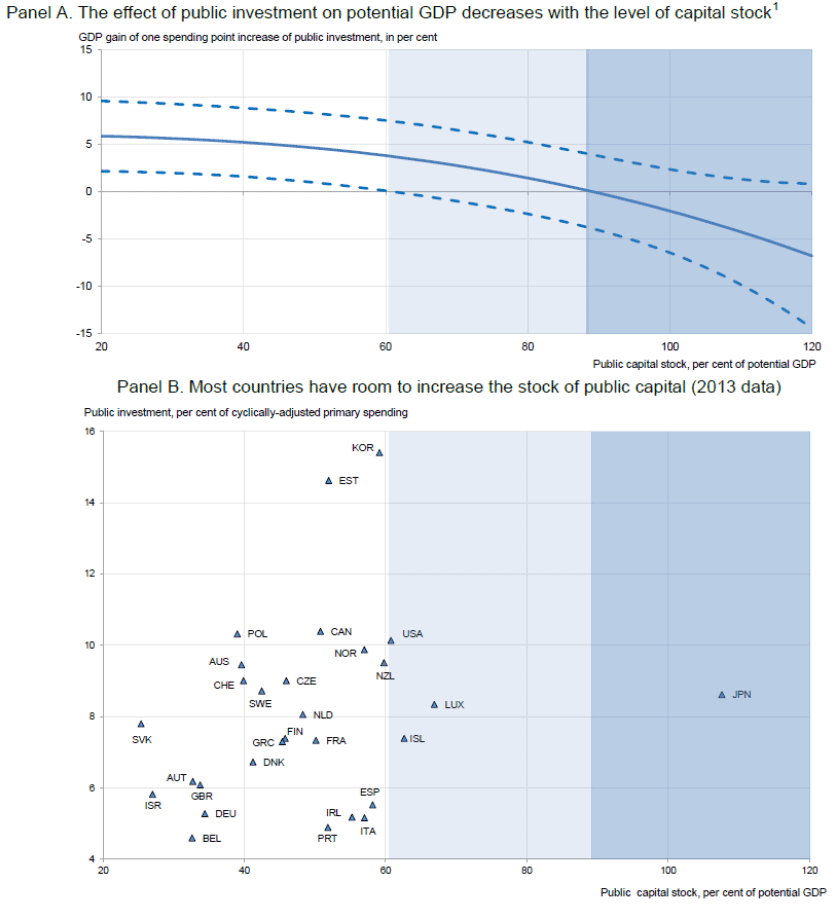
Source: Organisation for Economic Co-operation and Development (2016)[13]. Dashed line indicates 95% confidence interval.
26. This analysis of the ‘optimal’ level of infrastructure investment therefore suggests that there is room to increase the stock of capital.
V. What Might the Potential Economic Benefit be from Increasing Infrastructure Invesment in Scotland?
27. The Scottish Government’s National Infrastructure Mission envisages an increase in annual infrastructure investment by 1% of GDP in 2017, or £1.56 billion, by the end of the next Scottish Parliament in 2025-26.
28. This section of the paper illustrates the potential economic benefit from such public investment by undertaking economic modelling. As described earlier in the paper, the OECD (2016b) report used three different economic models to quantify the extent to which an increase in public investment can lift economic growth (see summary in Table 1).[14] Across all three models used, the stimulus package was set at 0.5% of GDP and the finding was that the average long term output gains were between 0.5% to 2% in the large advanced economies.
29. The range of average output gains in large advanced economies reflects the nature of the three models used with one model finding a 2% increase, another finding 1.6% increase and the NiGEM model[15] finding the lowest impact, at 0.5%. The NiGEM model found lower impacts on growth mainly because the model has greater modelling of international trade. This means that, for example, increases to demand can lead to higher import demand from other countries, which partly offsets some of the increase in GDP, particularly for more open economies.
30. The Scottish Government holds a Scottish version of NiGEM known as SGGEM (Scottish Government Global Econometric Model) and this is used in this paper to model the economic effects of the additional investment package.
31. The modelling assumes that the National Infrastructure Mission leads to a sustained change in investment in Scotland, with investment assumed to continue at the level reached, beyond 2025-26.
32. The model produces outputs on capital stock, productivity and real disposable household income, as well as aggregate measures of the economy such as GDP.
33. The impact of the investment package on capital stock is shown in Figure 6. The capital stock is a key driver of long term economic performance as having a higher level of capital intensity in the economy typically allows workers to be more productive.
Figure 6: Percentage Change in Capital Stock from the Investment Package
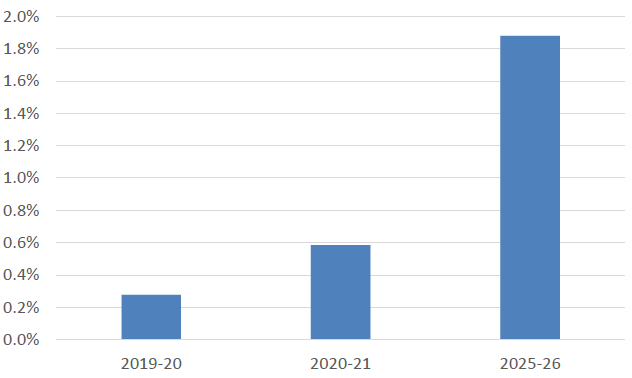
Source: Scottish Government Global Econometric Model
34. The investment package also leads to improvement in labour productivity and real disposable incomes, as shown in Figure 7.
Figure 7: Percentage Change in Labour Productivity and Real Incomes from the Investment Package
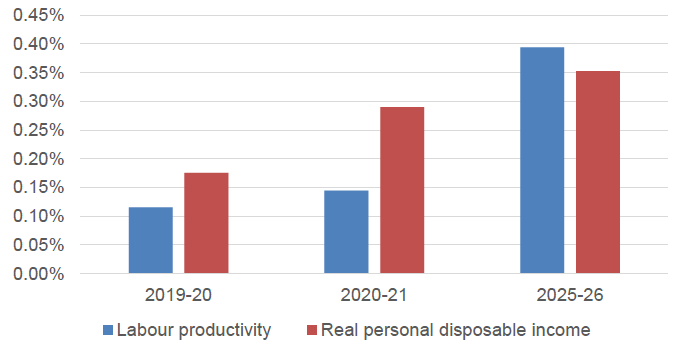
Source: Scottish Government Global Econometric Model
35. The investment package leads to sustained increases in the size of the economy, as shown in Figure 8. It shows that by 2025-26, the Scottish economy could be around between 0.5% and 1% larger than it would otherwise be, depending on the measure used. There would also continue to be a longer term impact as a higher capital stock ultimately feeds through to higher productivity.
36. The two alternative measures of the economy shown in Figure 8 are: GDP, which measures all economic activity, and GDP excluding net trade, also known as domestic demand. As highlighted above, the increase in domestic demand is larger than the increase in overall GDP. This highlights the finding, consistent with the range of international results presented in the previous section, that assumptions around international trade have a material impact on the results. Across both measures, the increase in economic activity builds over time.
Figure 8: Percentage change in alternative measures of the economy
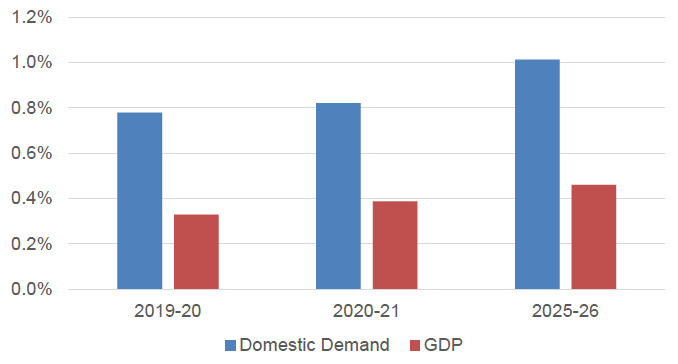
Source: Scottish Government Global Econometric Model
37. If investment is sustained after 2025-26, in total, over 15 years, it would equate to an additional £10 billion of GDP or £25 billion of domestic demand (2017 prices).
38. The cumulative results assume that the increase in investment is sustained. Even if the investment is not sustained at this higher level, overall economic output is still higher in the long run than if the investment had not occurred due to the boost to long term productive capacity of the economy.
39. This long-term economic benefit primarily arises from increases in the level of Scottish capital stock, which directly increases the potential output of the Scottish economy. This supply side effect is therefore the primary driver behind the increases in real GDP in the long-run.
40. These estimates (including net trade) are relatively similar in magnitude to the OECD findings.
Conclusions
41. There is a body of evidence which supports the general link between infrastructure spending leading to economic growth.
42. An annual increase in infrastructure investment of the scale envisaged in the National Infrastructure Mission could provide a boost to Scotland’s real GDP of between 0.5% and 1% in 2025-26, depending on the measure of the economy used. Over 15 years, this is equivalent to increasing the economy by between £10 billion and £25 billion (2017 prices), depending on the measure of the economy used.
43. Overall, and in common with the OECD results, the economic modelling finds that an investment led stimulus has both a short term demand effect but also a longer term supply effect.
44. The extent of economic benefits will be shaped by the efficiency of the individual public investment projects. Ultimately, the balance of investment between different types of activity, sectors and markets will determine the precise level of economic benefits realised from the infrastructure investment package.
Contact
Email: Kathy Johnstone
There is a problem
Thanks for your feedback